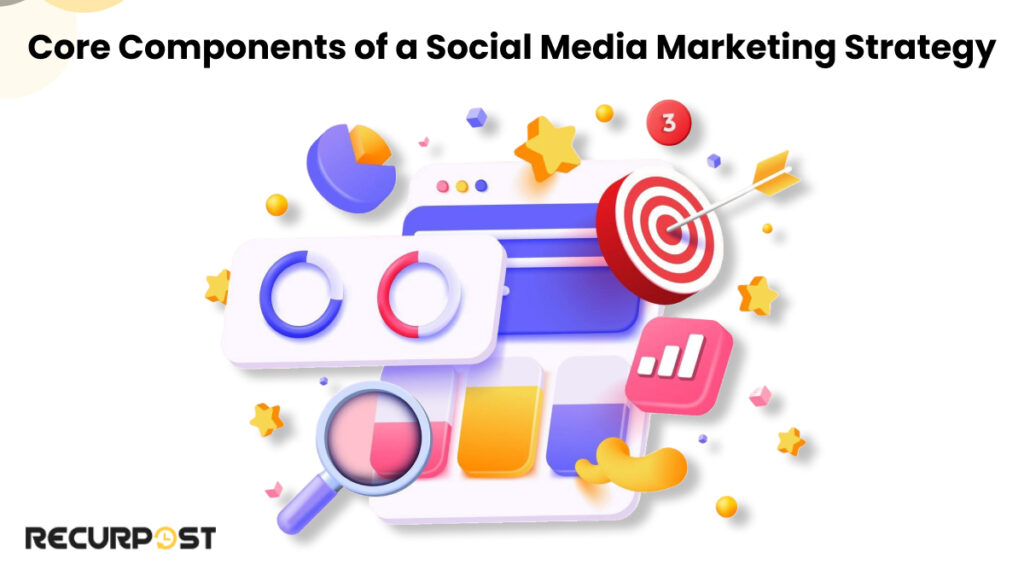A marketing strategy for social media isn’t just about posting often; it’s about posting with purpose.
If your content isn’t bringing in leads or building real connections, it’s time to change how you plan. A solid marketing strategy for social media helps you stay consistent, reach the right people, and turn your followers into customers.
This guide walks you through how to build a plan that works even if you’re starting from zero. You’ll learn how to set smart goals, choose the right platforms, create content people care about, and measure what’s actually helping your business grow.
We’ll break everything down step by step so you can stop guessing and start growing. Whether you’re managing your own business or running social for a team, this strategy will help you stay focused and get results.
If you’re tired of posting just to stay visible and want your efforts to lead somewhere, you’re in the right place. Let’s build a plan that does more than just fill your feed.
What is Social Media Marketing?
A social media marketing strategy uses platforms like Facebook, Instagram, LinkedIn, TikTok, and Twitter to promote products, services, or brands to a target audience. This type of digital marketing combines content creation, community management, and paid ads to build customer relationships, strengthen brand awareness, and drive measurable business results.
Unlike traditional advertising, social media marketing creates two-way conversations between brands and customers. A successful marketing strategy engages people through posts, comments, stories, and direct messages, building trust, generating leads, and turning followers into customers with authentic connections.
It includes organic posting, community engagement, influencer marketing, and paid social ads across multiple platforms. A strong social media strategy meets customers where they already spend time online, offering a direct path to build brand awareness, increase engagement, and drive conversions.
How is a Social Marketing Strategy Different?

A social media marketing strategy documents how a business uses platforms to achieve marketing goals. These strategies prioritize speed, feedback, and real-time content adaptation, since social media moves fast, publicly, and fosters two-way communication with a target audience.
A solid marketing strategy goes beyond posting. It should guide when to post, what to post, and how to create content that builds trust with your audience while maintaining a consistent brand voice.
Key differences between a social media strategy and traditional marketing strategies include:
- Real-time content: Trends shift quickly. A social media marketing plan should allow space to act on viral moments while aligning with business objectives.
- Two-way communication: A post that works on TikTok may fail on LinkedIn. A successful social media strategy requires platform-specific planning, so reviewing social media marketing examples across platforms is essential.
- Platform-first thinking: A post that works on TikTok won’t always work on LinkedIn. You need separate ideas for different social media platforms, which is why studying social media marketing examples across various channels is so important.
- Analytics that update daily: Feedback arrives instantly. Your marketing strategy should adapt quickly, tracking key performance indicators (KPIs) to refine ongoing social media efforts.
Social media managers need integrated workflows powered by scheduling platforms, social media management software, and analytics tools instead of static documents.
A strong marketing strategy for social platforms enables purposeful posting across channels to generate leads, encourage user-generated content, and achieve measurable results aligned with business goals.
Core Components of a Social Media Marketing Strategy
Successful marketing strategies address the basics: what to post, where to post, and why. Instead of complex dashboards, a clear marketing strategy answers these questions.

Essential components of a successful social media strategy include:
1. Goals That Make Sense
Set business-aligned social media goals instead of chasing likes. Track reach, impressions, and brand awareness, then measure clicks, conversions, and lead generation metrics.
2. A Clear Target Audience
Focus your targeting by considering:
- Who buys from you
- What problems are they trying to solve
- Where do they spend time online
- Their age groups and audience demographics
Knowing your target audience prevents wasted posts and helps build an active community reflecting your brand’s values.
3. Platform Plans
Create separate plans for each platform:
- Instagram: Reels, Stories, and product tags
- LinkedIn: Thought leadership and company updates
- Facebook: Groups and ads
- TikTok: Trends, challenges, and behind-the-scenes
- Twitter: Quick updates and threads
Effective social media marketing campaigns adapt to multiple platforms while maintaining a consistent voice and brand identity.
4. A Content Strategy That Keeps You Posting
Create a content strategy with: daily themes (tips, promos, stories), formats (videos, carousels, memes, Q&As), and content calendars supported by tools like RecurPost. Posting 5–7 times weekly is easier with clear content planning.
5. A Way to Track What’s Working
Your social media strategy should track:
- Engagement (likes, comments, shares)
- Follower growth
- Click-throughs
- Reach and impressions
- Conversions
- Data from tools like Google Analytics
Keep it simple. A spreadsheet works if you update it weekly.
A successful social media strategy sustains visibility, connects with your audience, and drives measurable business objectives, not just fills a feed.
Conducting Competitive Analysis

Competitive analysis strengthens your social media strategy by studying how competitors engage with different demographics and by tracking performance metrics to refine tactics that drive customer engagement and inquiries.
Competitor insights shape marketing strategies that connect with your target audience through consistent posting, educational content, and a clear brand voice across social media platforms. Tools like Sprout Social and Google Analytics support competitive analysis, track key metrics, and measure progress against business goals to maintain an edge.
Build Content Pillars to Stay Consistent

Content pillars are 3–5 recurring topics that form the backbone of a social media marketing strategy, ensuring brand voice consistency and alignment with business objectives across platforms.
Each pillar supports your strategic goals and strengthens overall content marketing efforts. For example:
- Tips and how-tos → build trust and drive customer engagement
- Behind-the-scenes → expand social media presence
- User-generated content → provide social proof and boost credibility
- Product features → reinforce marketing campaigns
- Trends or FAQs → reflect audience feedback and show active listening
No guessing needed: use social listening or review comments to see what your target audience values. Then map each pillar to a day or format in your content calendar for consistent posting.
This keeps messaging sharp and helps you create engaging content that performs better across every social marketing strategy, without starting from scratch each week.
Step-by-Step: Building a Social Marketing Strategy
Building a social marketing strategy requires clarity in each step for daily posting, starting with basic tools rather than months of planning.

To build from scratch:
Step 1: Check Where You Stand
Audit your posts: what gains engagement, what flops, and whether you’re on the right social media platforms. Use RecurPost or platform insights to track metrics. Tools like Sprout Social or Google Analytics reveal customer inquiries, website traffic, and performance metrics.
Step 2: Set Real Goals
Choose 1–3 clear social media goals:
- Build trust → track engagement
- Grow traffic → monitor clicks and website traffic
- Sell more → measure leads or purchases
Each post should support one business objective.
Step 3: Define Your Audience
Ask: Who am I talking to? What problems do they face? How do they speak? What do they share? This clarifies target audience analysis, brand voice, and visuals.
Step 4: Pick Your Platforms
Pick 2–3 social media channels where your audience is active:
- B2B → LinkedIn, Twitter
- B2C → Instagram, Facebook, TikTok
Choose platforms where you can post consistently to avoid posting without a plan.
Step 5: Plan the Content
Create a content strategy with a weekly content calendar. Avoid random posting, leave space for trending topics, and prepare evergreen posts for slower days.
Step 6: Engage Like a Human
Reply to comments, like posts, and ask questions. Brands that show two-way communication build stronger audience engagement.
Step 7: Track, Review, Adjust
Review monthly: identify what’s working, what to stop, and what to repurpose. Regular reviews strengthen your social media marketing plan and sharpen ROI calculation.
The best marketing strategy fits your tools, time, and team. Be effective where you are, not everywhere. Learning from social media marketing strategy examples helps refine your own approach.
Practical Social Media Marketing Tactic
Social media tactics are the specific actions that bring a marketing strategy to life, helping execute plans effectively across different platforms.
1. Content Creation Tactics
Transform content pillars into engaging posts with these approaches:
- Storytelling posts that connect emotionally with your target audience
- Educational carousels that simplify topics
- User-generated content campaigns showcasing real customers
- Behind-the-scenes videos that humanize your brand identity
- Polls and questions that boost engagement and capture audience feedback
2. Growth Tactics
Expand your reach with these methods:
- Hashtag research to find trending and niche tags
- Collaboration posts with brands or influencers
- Comment pods to engage consistently
- Giveaways and contests that encourage sharing
- Cross-promotion across social media channels
3. Engagement Tactics
Build connections with these interaction techniques:
- Response templates for common questions
- Personalized replies addressing followers by name
- A comment-first approach to spark two-way communication
- Social listening to join industry conversations
- Community spotlights highlighting active followers
4. Conversion Tactics
Convert followers to customers with these methods:
- Limited-time offers for social audiences
- Exclusive discount codes to track campaigns
- Strategic CTAs placed at peak engagement points
- Social proof highlights with testimonials and reviews
- Direct message campaigns for high-value prospects
These tactics reflect different types of social media marketing and show how to implement a broader marketing strategy. Mix and match based on goals, platforms, and target audience preferences to build a tactical plan that delivers measurable results.
Tips to Optimize Strategy Over Time
A marketing strategy for social media requires ongoing adaptation as platforms evolve. These tips sustain effectiveness while managing time and resources.
1. Reuse What Works
Each month, identify posts with the most engagement: likes, comments, shares, and saves. Repost top content with variations, swap visuals, or add new hooks. A smart content repurposing approach extends results.
2. Test Content Formats
Rotate content types to keep feeds fresh. For example, turn a long caption into a carousel to boost reach. Formats to test: Reels, short-form video, memes, quotes, carousels, behind-the-scenes clips.
3. Let Tools Save You Time
Rely on social media management platforms like RecurPost to: schedule weekly posts, spot content calendar gaps, and recycle evergreen posts automatically. This reduces last-minute work.
4. Update Your Audience Profile
Refresh your audience profile every few months: Are your followers the right target audience? Do their problems remain the same? Are they shifting toward short-form video like Reels? Regular updates refine your social media strategy.
5. Monitor Analytics Closely
Track key metrics weekly: follower growth, reach, clicks, engagement rate, and conversion rate. Consistent analytics monitoring strengthens decision-making and improves posting outcomes.
Smart social media marketing means better results, not just more work.
Mistakes to Avoid
These common mistakes can weaken a social media marketing strategy. Fixing them saves time, energy, and helps achieve business goals.
1. Posting Without a Plan
Random posting causes missed marketing goals and prevents tracking.
Fix: Use a weekly or monthly content calendar as part of your content planning routine.
2. Copying Content Across Platforms
Content must match each platform. A tweet won’t succeed on Instagram, and TikTok clips may flop on Facebook.
Fix: Apply platform-specific tactics by adjusting captions, tone, and formats.
3. Ignoring the Comments
Failing to respond hurts audience engagement and weakens social media success.
Fix: Reply quickly, be authentic, and use follower names for better two-way communication.
4. Only Watching Follower Count
Large numbers don’t equal results. A smaller engaged target audience drives better outcomes.
Fix: Focus on meaningful metrics like clicks, shares, and comments.
5. Skipping Analytics
Without tracking, a marketing strategy relies on guesswork.
Fix: Monitor at least three key metrics: reach, engagement, and clicks for actionable insights.
6. Doing It All Yourself
Trying to do everything alone wastes time.
Fix: Use social media management software like RecurPost to automate scheduling, repurpose posts, and maintain consistency.
A successful social media strategy aligns with your business objectives, team, and available time. Following these fixes simplifies execution and strengthens your overall marketing strategy.
Conclusion
A strong marketing strategy prevents wasted effort, ensures purposeful posting, and delivers measurable results across social media platforms.
Effective social media marketing relies on systems for consistent posting, audience engagement, and two-way communication, not just large teams.
Begin with:
- Define a few clear business goals
- Select platforms that match your target audience
- Build a content strategy that fits your time
- Use key metrics to track progress and align with broader marketing efforts
- Adjust regularly based on performance
Properly executed social media marketing strategies maximize efficiency, strengthen brand awareness, and improve overall marketing strategy performance.
FAQs on Marketing Strategy for Social Media
1. How long does it take to build a good social media marketing plan?
You can build a basic one in a day. A full strategy with research and a posting calendar usually takes 1–2 weeks.
2. Should I use paid ads as part of my marketing strategy?
Yes, if you want faster results. Ads can boost reach and help test content before using it organically.
3. How many platforms should I be on?
Stick to 2–3 social networks where your target age groups and younger audiences are active. Managing multiple platforms without a clear plan often spreads your social efforts too thin.
4. What tools help track content performance?
Use built-in platform analytics. For better tracking, tools like RecurPost, Buffer, or Sprout Social can combine your data in one place.
5. How often should I post?
Aim for 5–7 times per week across all platforms. Focus on quality over volume.
6. Do hashtags still matter in social media marketing?
Yes, but use them wisely. Go for a mix of niche and popular hashtags. Keep them relevant to the post.
7. What if my content isn’t getting engagement?
Try different formats. Switch your timing. Ask questions. Also, check if your audience has changed.
8. Can I run a social media strategy solo?
Yes, but use scheduling and automation tools. That’s how solo marketers stay consistent without burning out. Create engaging content that reflects your own strategy and supports broader business objectives.

As a passionate content writer, I love blending creativity with research to craft compelling narratives that inform, engage, and inspire. With a strong focus on user engagement and brand communication, I create content that resonates with the audience and drives meaningful interactions.





